Assessment and Promotion Strategy of Rural Resilience in Yangtze River Delta Region, China
Abstract
:1. Introduction
2. Materials and Methods
2.1. Study Process
2.2. Study Area
2.3. Data Preprocessing
2.4. Assessment Framework of Rural Resilience
2.5. Weight Assignment by Coefficient of Variation Method
2.6. RRI Calculation by TOPSIS Method
2.7. Spatial Correlation Pattern Analysis by ESDA Method
2.7.1. Global Spatial Autocorrelation Analysis
2.7.2. Local Spatial Autocorrelation Analysis
2.8. Rural Development Type Division by K-Means Clustering Algorithm
3. Results
3.1. The Spatio-Temporal Evolution of Rural Resilience
3.1.1. The Temporal Evolution of RRI
3.1.2. The Spatial Evolution of RRI
3.2. The Spatial Correlation Pattern of Rural Resilience
3.2.1. The Results of Global Spatial Autocorrelation Analysis
3.2.2. The Results of Local Spatial Autocorrelation Analysis
3.3. Clustering Results
3.3.1. Five Types of Rural Development
3.3.2. General Characteristics of Each Type of Rural Area
3.3.3. Resilience Promotion Strategy
4. Discussion
- (1)
- Considering the workload, this paper only selects 153 counties (including county-level cities) in the Yangtze River Delta region as research units. But in fact, the geographical scope of the study area at different times should be completely different. Although these 153 research units are typical to some extent, they cannot accurately represent the overall developmental state of rural areas in the whole region. Therefore, in future studies, scholars need to consider the differences in the study area at different times, so as to more accurately assess the regional rural resilience in different years.
- (2)
- The rationality of the evaluation index system needs further consideration. Firstly, objective indicators are only used to construct an index system of rural resilience, but subjective evaluation methods are not taken into account. Therefore, anthropological methods such as interviews and field investigations could be used in future research [71]. Secondly, the regional characteristics of the evaluation index system are insufficient. Future studies can highlight the uniqueness of the rural areas in the Yangtze River Delta region in terms of physical geography, hydrological and climatic environment and stages of social development.
- (3)
- Due to the limitation of time, this study only adopted a geographical research method from a macro perspective, and did not include planning and design, built environment and hardware facilities in the research scope [72,73]. Given this, future research could be combined with plan-level research methods to enhance the specificity and operability of the research conclusions.
5. Conclusions
Author Contributions
Funding
Institutional Review Board Statement
Data Availability Statement
Conflicts of Interest
References
- Martin, R. Regional economic resilience, hysteresis and recessionary shocks. J. Econ. Geogr. 2012, 12, 1–32. [Google Scholar] [CrossRef]
- Ahmed, S. Collaborative resilience: Moving through crisis to opportunity. Community Dev. 2013, 44, 395–397. [Google Scholar] [CrossRef]
- McManus, P.; Walmsley, J.; Argent, N.; Baum, S.; Bourke, L.; Martin, J.; Pritchard, B.; Sorensen, T. Rural community and rural resilience: What is important to farmers in keeping their country towns alive. J. Rural. Stud. 2012, 28, 20–29. [Google Scholar] [CrossRef]
- Meng, G.; Gebhardt, H. Rural Development and Transformation in the Federal Republic of Germany since the 1950s. Acta Geogr. Sin. 2011, 66, 1644–1656. [Google Scholar]
- Zhao, W. 1950–2010: The Overview of Rural Development and Planning Strategy in Post-War Europe. Dev. Small Cities Towns 2019, 37, 5–11. [Google Scholar]
- Yang, X. The Exploration of Values in the Rural Revitalization in Japan: A Case Study of Noto’s Satoyama and Satoumi. Urban Plan. Int. 2016, 31, 115–120. [Google Scholar] [CrossRef] [Green Version]
- Li, Q.; Zander, P. Resilience building of rural livelihoods in PES programmes: A case study in China’s Loess Hills. Ambio 2020, 49, 962–985. [Google Scholar] [CrossRef]
- Wilson, G.A.; Hu, Z.; Rahman, S. Community resilience in rural China: The case of Hu Village, Sichuan Province. J. Rural. Stud. 2018, 60, 130–140. [Google Scholar] [CrossRef] [Green Version]
- Cutter, S.L.; Ash, K.D.; Emrich, C.T. Urban-rural differences in disaster resilience. Ann. Am. Assoc. Geogr. 2016, 106, 1236–1252. [Google Scholar] [CrossRef]
- Freshwater, D. Vulnerability and resilience: Two dimensions of rurality. Sociol. Rural. 2015, 55, 497–515. [Google Scholar] [CrossRef] [Green Version]
- Tolossa, D. Rural Livelihoods, Poverty and Food Insecurity in Ethiopia. Ph.D. Thesis, Norwegian University of Science and Technology, Trondheim, Norway, 2005. [Google Scholar]
- Yuan, J. Essays on New Village Architecture in Hong Kong. Archit. J. 1987, 6, 50–56. [Google Scholar]
- Zhang, J. Prospects for coordinated development of urban and rural communities. Truth Seek. 2006, S2, 192–193. [Google Scholar]
- Wang, X.; Zhang, Q. Rural settlements and economical land use. Jiangsu Economic News, 19 January 2006; p. A01. [Google Scholar]
- Wang, H.; Xu, Y.; Lu, S.; Ren, Y.; Xiang, W. A Comparative Study of Chinese Translation of Resilience Terminology in Socio-Ecological System and Its Related Research Fields. Urban Plan. Int. 2017, 32, 29–39. [Google Scholar] [CrossRef] [Green Version]
- Zautra, A.; Hall, J.; Murray, K. Community development and community resilience: An integrative approach. Community Dev. 2008, 39, 130–147. [Google Scholar] [CrossRef]
- Maguire, B.; Hagan, P. Disasters and communities: Understanding social resilience. Aust. J. Emerg. Manag. 2007, 22, 16–20. [Google Scholar]
- Kelly, C.; Ferrara, A.; Wilson, G.A.; Ripullone, F.; Nolè, A.; Harmer, N.; Salvati, L. Community resilience and land degradation in forest and shrubland socio-ecological systems: Evidence from Gorgoglione, Basilicata, Italy. Land Use Policy 2015, 46, 11–20. [Google Scholar] [CrossRef] [Green Version]
- Li, T. New Progress in Study on Resilience Cities. Urban Plan. Int. 2017, 32, 15–25. [Google Scholar] [CrossRef]
- Cai, J.; Guo, H.; Wang, D. Review on the Resilience City Research Overseas. Prog. Geogr. 2012, 31, 1245–1255. [Google Scholar]
- Rudiarto, I.; Handayani, W.; Wijaya, H.B.; Insani, T.D. Rural livelihood resilience: An assessment of social, economic, environment, and physical dimensions. In Proceedings of the 5th International Conference on Sustainable Built Environment (ICSBE 2018), Banjarmasin, Indonesia, 11–13 October 2018; pp. 1–12. [Google Scholar]
- Wang, T. Research on the Resilience of Rural Development under the Background of Modernization. Master’s Thesis, Zhejiang Normal University, Jinhua, China, 2019. [Google Scholar]
- Li, H. Rural Settlements Research from the Perspective of Resilience Theory. Sci. Geogr. Sin. 2020, 40, 556–562. [Google Scholar]
- Rose, A. Defining and measuring economic resilience to disasters. Disaster Prev. Manag. 2004, 13, 307–314. [Google Scholar] [CrossRef]
- Heijman, W.; Hagelaar, G.; Heide, M. Rural Resilience as a New Development Concept. In EU Bioeconomy Economics and Policies: Volume II. Palgrave Advances in Bioeconomy: Economics and Policies; Dries, L., Heijman, W., Jongeneel, R., Purnhagen, K., Wesseler, J., Eds.; Palgrave Macmillan: Cham, Switzerland, 2019; pp. 195–211. [Google Scholar]
- Colding, J. ‘Ecological land-use complementation’ for building resilience in urban ecosystems. Landsc. Urban Plan. 2007, 81, 46–55. [Google Scholar] [CrossRef]
- Zhao, R.; Fang, C.; Liu, H. Progress and propect of Urban resilience research. Prog. Geogr. 2020, 39, 1717–1731. [Google Scholar] [CrossRef]
- Li, Y.; Chen, W.; Sun, Y. New reflections on the analysis of regional resilience in geographical sciences from a relational-dynamic perspective. Geogr. Res. 2019, 38, 1694–1704. [Google Scholar]
- Young, R.C.; MacCannell, D. Predicting the quality of life in the United States. Soc. Indic. Res. 1979, 6, 23–40. [Google Scholar] [CrossRef]
- Cox, R.S.; Hamlen, M. Community disaster resilience and the rural resilience index. Am. Behav. Sci. 2015, 59, 220–237. [Google Scholar] [CrossRef]
- Jurjonas, M.D. A Framework for Rural Coastal Community Resilience: Assessing Diverse Perceptions of Adaptive Capacity for Climate Change. Ph.D. Thesis, North Carolina State University, Raleigh, NC, USA, 2018. [Google Scholar]
- Khatibi, S.A.; Golkarian, A.; Mosaedi, A.; Hamdollah, S.Q. Assessment of resilience to drought of rural communities in Iran. J. Soc. Serv. Res. 2019, 45, 151–165. [Google Scholar] [CrossRef]
- Tang, D.; Mao, M.; Shi, J.; Hua, W. The Spatio-Temporal Analysis of Urban-Rural Coordinated Development and Its Driving Forces in Yangtze River Delta. Land 2021, 10, 495. [Google Scholar] [CrossRef]
- Zhao, W.; Liu, X.; Deng, Q.; Li, D.; Xu, J.; Li, M.; Cui, Y. Spatial Association of Urbanization in the Yangtze River Delta, China. Int. J. Environ. Res. Public Health 2020, 17, 7276. [Google Scholar] [CrossRef]
- Xu, W.; Ming, X.; Ma, Y.; Zhang, X.; Shi, P.; Zhuo, L.; Lu, B. Quantitative Multi-Hazard Risk Assessment of Crop Loss in the Yangtze River Delta Region of China. Sustainability 2019, 11, 922. [Google Scholar] [CrossRef] [Green Version]
- Wu, H.; Huang, A.; Huang, X. Variation Characteristics of Seasons in the Yangtze River Delta during the Past 50 Years. Chin. J. Agrometeorol. 2012, 33, 317–324. [Google Scholar]
- Yue, L. Research on the Development Mode of Yangtze River Delta Region under the Background of Urban-Rural Integration. Urban Transp. Constr. 2021, 7, 32–35. [Google Scholar]
- Yue, L.; Xu, K.; Shi, G. Property Analysis and Method Selection of the Indexes Being Dimensionless. J. Stat. Inf. 2020, 35, 3–9. [Google Scholar]
- Yan, J. Study on the Rural Territorial System Differentiation and Its Regulation in Beijing-Tianjin-Hebei Region. Master’s Thesis, University of Chinese Academy of Sciences, Beijing, China, 2020. [Google Scholar]
- Gebrekidan, G.G. Resilience of Rural Households to Food Insecurity in Ahferom Wereda, Central Zone of Tigray National Regional State, Ethiopia. Ph.D. Thesis, Addis Ababa University, Addis Ababa, Ethiopia, 2019. [Google Scholar]
- Zhang, C.; Jiang, Z.; Han, B.; Tan, D. Review on natural capital valuation. Acta Ecol. Sin. 2021, 41, 9174–9185. [Google Scholar] [CrossRef]
- Ge, D.; Yu, S.; Liu, B. Research on Social, Production Capital and the New-Types Farmers’Willingness to Professional Train. J. Xinyang Agric. For. Univ. 2021, 31, 40–45. [Google Scholar]
- Liu, R. Study on the Influence of Rural Human Capital on Agricultural Economic Growth in Heilongjiang Province. Master’s Thesis, Heilongjiang Bayi Agricultural University, Daqing, China, 2021. [Google Scholar]
- Bian, Y. Source and Functions of Urbanites’ Social Capital: A Network Approach. Soc. Sci. China 2004, 3, 137–145. [Google Scholar]
- Guo, L. Characteristics, problems and operational risks of rural social governance system in developed areas: A case study of rural areas in Yangtze River Delta region. Huxiang Forum 2021, 34, 37–46. [Google Scholar]
- Zhang, H.; Li, X. Dicussion on the livelihood framework design of returning fishermen from the perspective of sustainable livelihood theory. Chin. Fish. Econ. 2022, 40, 102–110. [Google Scholar]
- Krantz, L. The Sustainable Livelihood Approach to Poverty Reduction; Swedish International Development Cooperation Agency: Stockholm, Sweden, 2001; pp. 1–27. [Google Scholar]
- Javed, A.M.; Bill, P. Financial capital as a shaper of households’ adaptive capabilities to flood risk in northern Bangladesh. Ecol. Econ. 2022, 195, 107381. [Google Scholar]
- Huang, Y. Research on Local Government Effectiveness Evaluation. Master’s Thesis, Nanjing Normal University, Nanjing, China, 2021. [Google Scholar]
- Yang, Y. Evaluation and Analysis of Weight Assignment Method in Multi-index Comprehensive Evaluation. Stat. Decis. 2006, 13, 17–19. [Google Scholar]
- Hwang, C.L.; Yoon, K.S. Multiple Attribute Decision Making; Springer: Berlin/Heidelberg, Germany, 1981. [Google Scholar]
- Li, Z.; Wang, R.; Shen, X. Cultivated Land Protection Zoning Based on Quality Index and Spatial Autocorrelation. Chin. J. Soil Sci. 2021, 52, 785–792. [Google Scholar]
- Wu, G.; Zhang, J.; Yuan, D. Automatically Obtaining K Value Based on K-means Elbow Method. Comput. Eng. Softw. 2019, 40, 167–170. [Google Scholar]
- Zhou, L.; Sun, N.; Miao, H. Polarization Effect and Spread Effect: The Role of the Yangtze River Delta in Regional Balanced Development: Evidence from Urban Agglomerations in the Yangtze River Delta and the Middle Reaches of the Yangtze River. Resour. Environ. Yangtze Basin 2021, 30, 782–795. [Google Scholar]
- Hou, S.; Zhen, Y.; Cao, X. Evaluation Index System of Urban Agglomeration Governance Under the Background of High-quality Development: A Case of the Yangtze River Delta. Econ. Geogr. 2022, 42, 35–44. [Google Scholar]
- Wang, W. Comparative Study on County Economic Development Paths between South Jiangsu and North Zhejiang. J. Commer. Econ. 2012, 15, 137–139. [Google Scholar]
- Chen, W. Discussion Once More on the Methodologies Applied in Protect the Historic Cities that a Strong Backbone to Well Proportioned: Two Cases of Protecting Roads Heritages in Historic Cities, Nanjing and Hangzhou. Architect 2013, 5, 85–95. [Google Scholar]
- Wu, Y. Research on Financial Agglomeration and Radiation Effects of Urban Groups in the Yangtze River Delta. Ph.D. Thesis, Soochow University, Suzhou, China, 2019. [Google Scholar]
- Zhu, G. Analysis of Measures to Promote Rural Economic Development in South Zhejiang Mountainous Area. Rural. Econ. Sci. Technol. 2017, 28, 154–155. [Google Scholar]
- Duan, J. Rural Population Flow in Anhui after Reform and Opening up. Agric. Archaeol. 2017, 3, 249–254. [Google Scholar]
- Chen, Y. Research on the Influencing Factors and Solutions of Regional Economic Imbalance under the Background of Yangtze River Delta Regional Integration Development. Bus. Econ. 2022, 2, 14–16. [Google Scholar]
- Wei, W. Early Warning of ‘Matthew Effect’ of Beijing-Tianjin-Hebei Coordinated Development: Problems, Causes and Suggestions. Soc. Sci. Guangxi 2017, 3, 64–68. [Google Scholar]
- Yu, H. Preliminary Study on the Development Experience of Zhejiang Province in 40 Years of Reform and Opening Up. Obs. Ponder. 2019, 4, 98–103. [Google Scholar]
- Duan, J. Restrictive Factors and Suggestions of County Economy Development in Anhui Province. Bus. Econ. 2013, 23, 40–41. [Google Scholar]
- Lin, X.; Xing, L.; Liu, Z. The Conceptual Basis of Natural Capital. Product. Res. 2020, 12, 16–19. [Google Scholar]
- Wang, S.; Cui, Z.; Lin, J.; Xie, J.; Su, K. Coupling Relationship between Urbanization and Ecological Resilience in the Pearl River Delta. Acta Geogr. Sin. 2021, 76, 973–991. [Google Scholar] [CrossRef]
- Wang, Y.; Li, Y.; Pan, B. Resilient Development Strategies of Precise Industrial Poverty Alleviation, Henan Province. Planners 2018, 34, 39–45. [Google Scholar]
- Pu, S.; Sun, W. Policy Research on the Construction of Rural Talents in the Implementation of Rural Revitalization Strategy. Chin. Public Adm. 2018, 11, 90–93. [Google Scholar]
- Wang, S.; Wang, D. Financial Support for the Rural Revitalization Strategy. China Financ. 2018, 4, 69–70. [Google Scholar]
- Cui, C. Analysis on the Distinctive Path of the Rural Industry Prosperity. Acad. J. Zhongzhou 2018, 8, 47–52. [Google Scholar]
- Xu, X. On Anthropological Methods: Fieldwork, Observation, or Life Introspection. J. Lanzhou Univ. 2016, 44, 84–95. [Google Scholar]
- Pan, S.; Ma, C. Evaluation Indicators System for the City Infastructure Development Level. Syst. Eng. 2007, 7, 88–91. [Google Scholar]
- Wang, J. The Research onto Quantified Analysis of Urban Spatial Morphology. Master’s Thesis, Chongqing University, Chongqing, China, 2004. [Google Scholar]
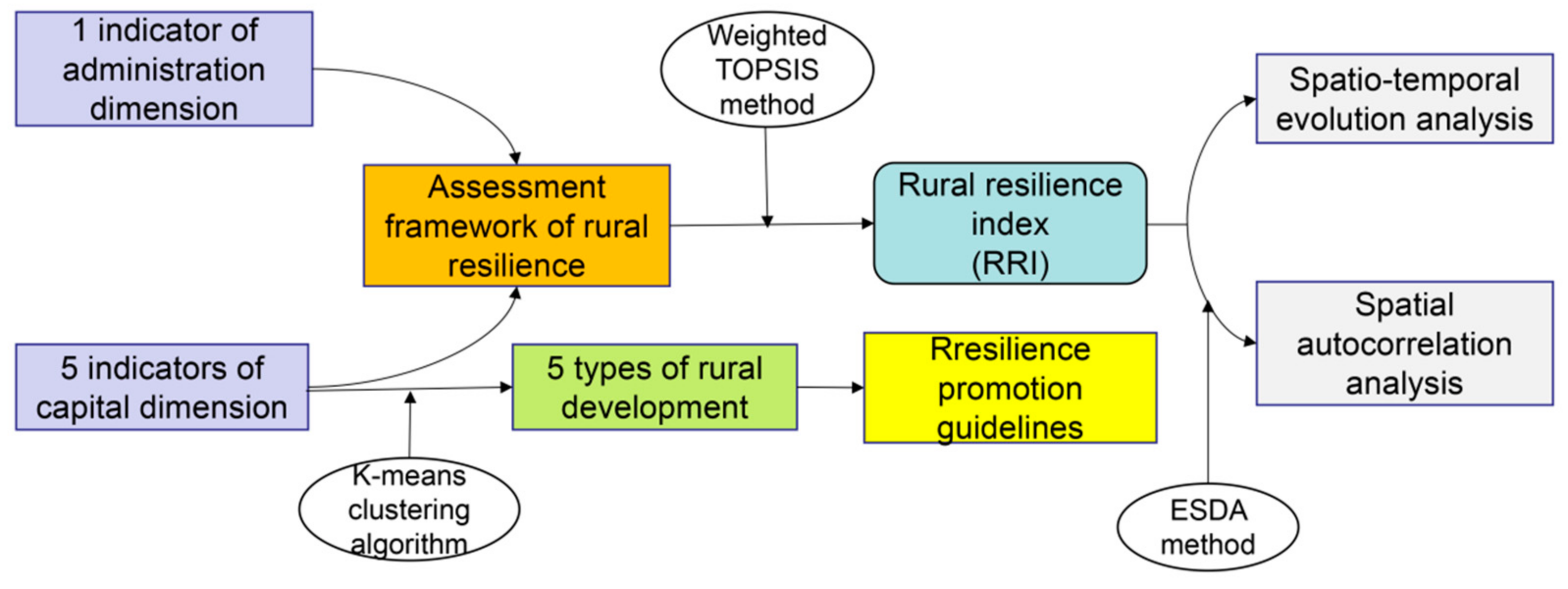

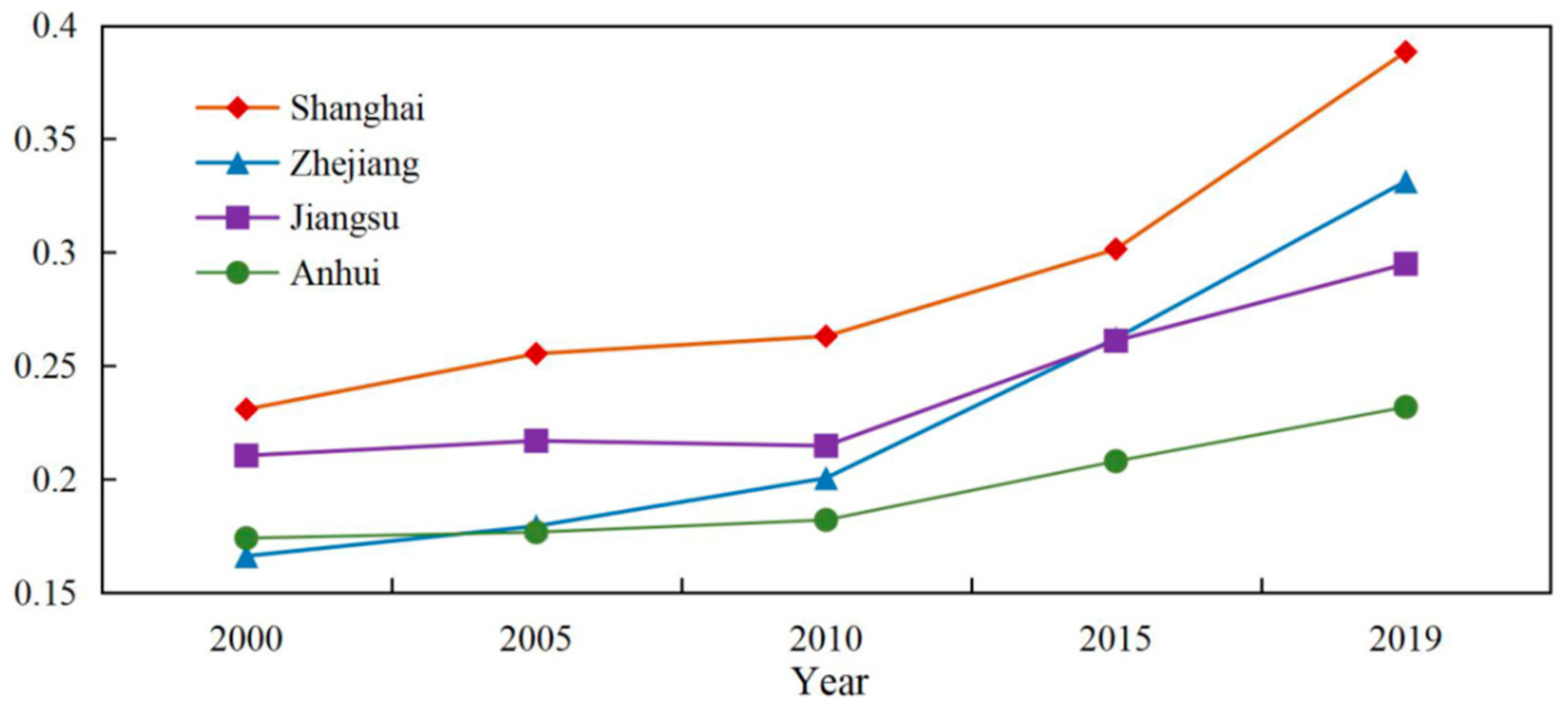
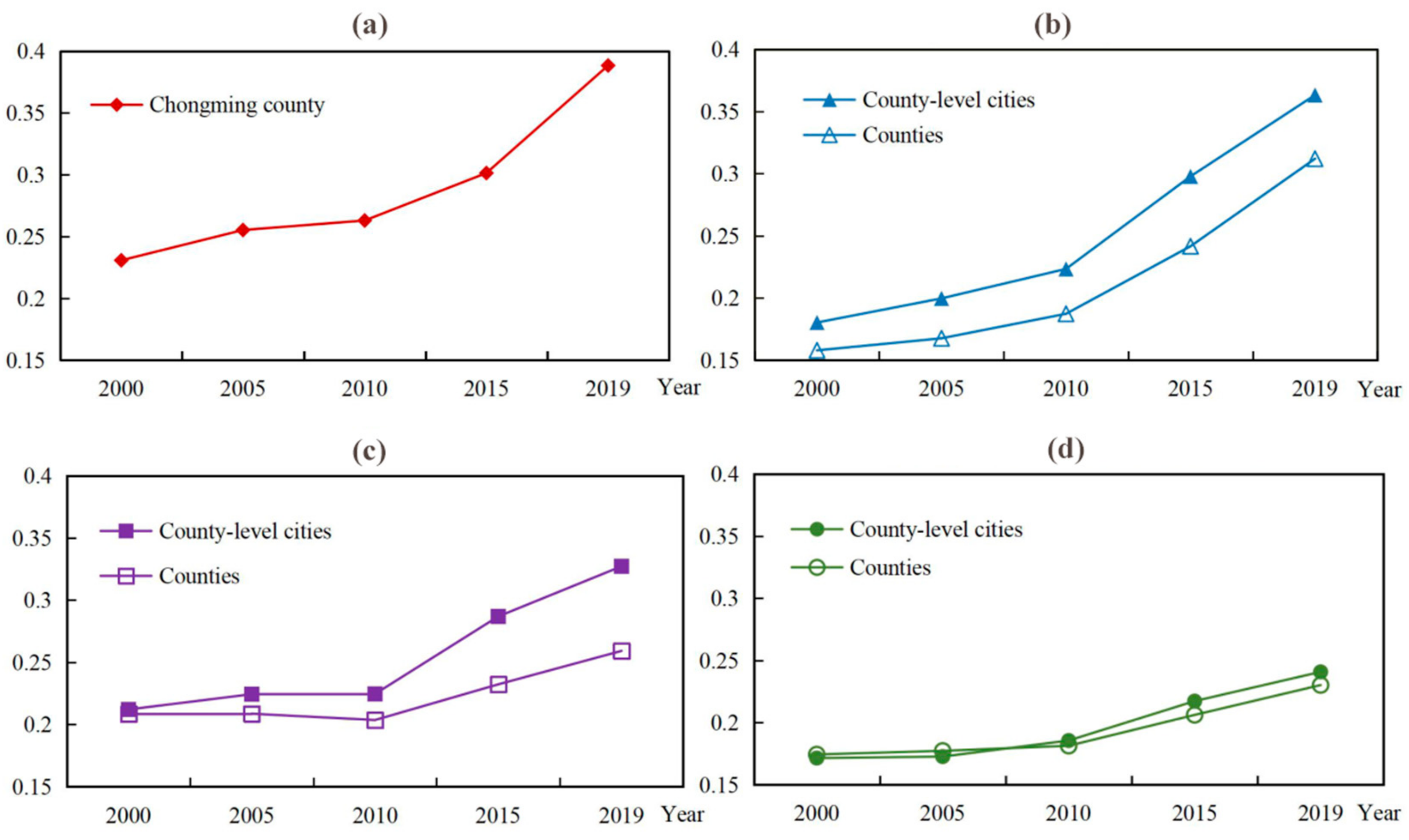

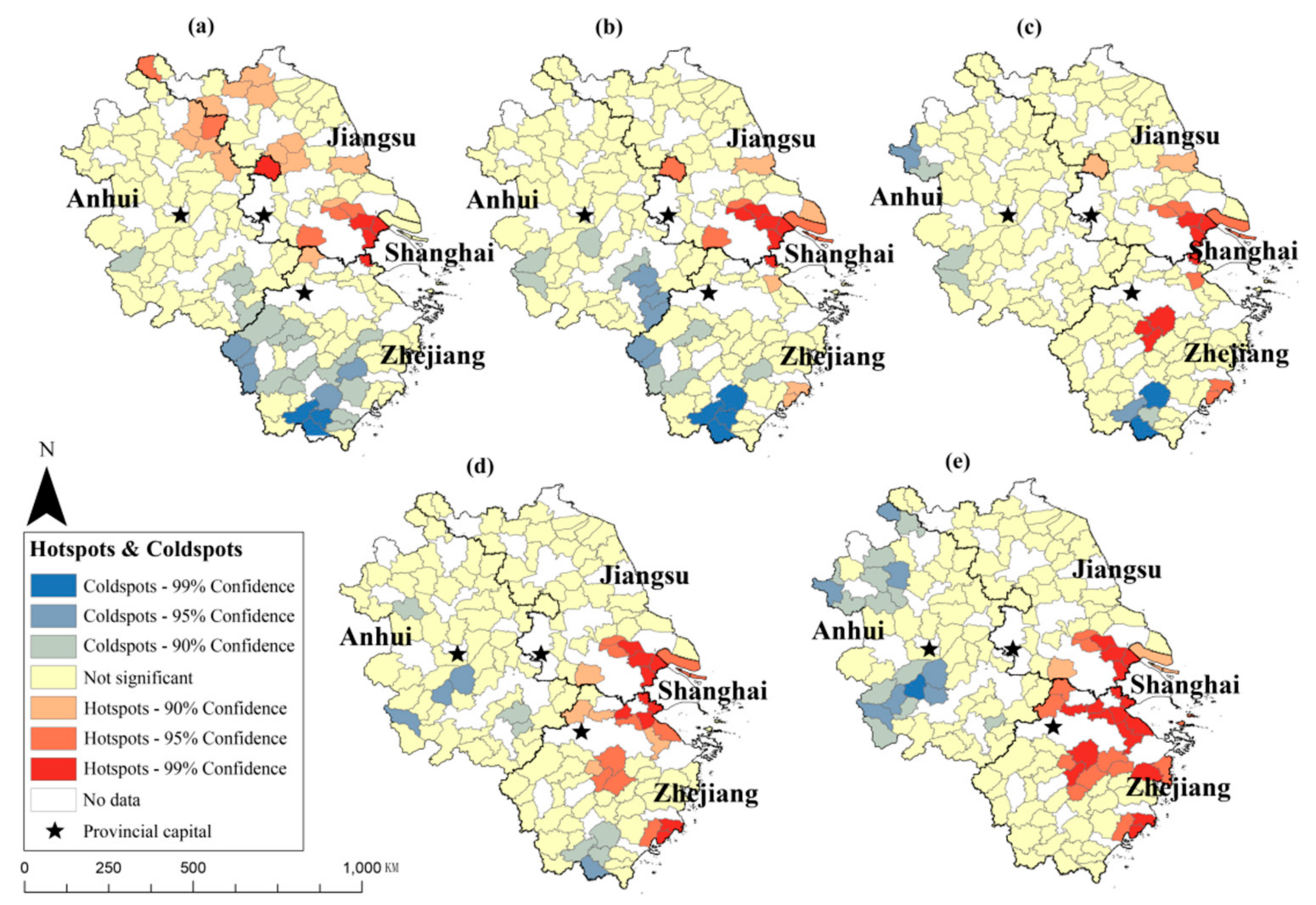
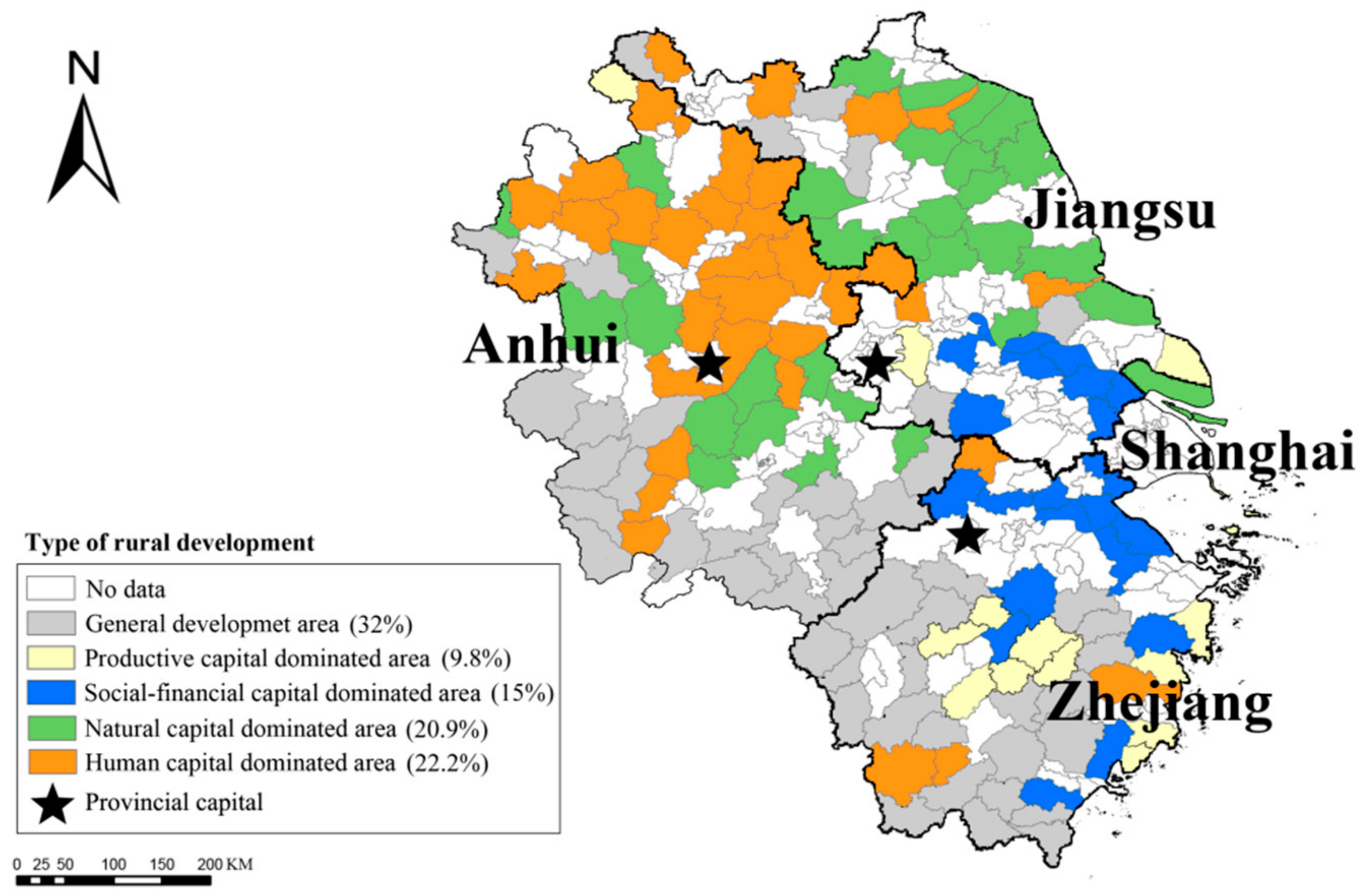
| Dimension | Main Factor | Measured Indicator |
|---|---|---|
| Capital | Natural capital (C1) | Per capita arable land area (C11) |
| Proportion of new afforestation area (C12) | ||
| Productive capital (C2) | Total power of agricultural machinery per capita (C21) | |
| Proportion of facility agriculture (C22) | ||
| Human capital (C3) | Proportion of primary and middle school students (C31) | |
| Proportion of secondary vocational school students (C32) | ||
| Social capital (C4) | Employment rate (C41) | |
| Fixed-line penetration (C42) | ||
| Financial capital (C5) | Per capita gross regional product (C51) | |
| Per capita disposable income of rural residents (C52) | ||
| Administration | Government effectiveness (A1) | Per capita public expenditure (A11) |
| Number of beds in medical institutions per 1000 population (A12) | ||
| Number of beds in welfare institutions per 1000 population (A13) |
| Year | 2000 | 2005 | 2010 | 2015 | 2019 |
|---|---|---|---|---|---|
| Moran’s I | 0.545 | 0.524 | 0.470 | 0.672 | 0.807 |
| Expectations Index | −0.007 | −0.007 | −0.007 | −0.007 | −0.007 |
| Variance | 0.006 | 0.006 | 0.006 | 0.006 | 0.006 |
| Z-score | 7.385 | 7.107 | 6.396 | 9.159 | 10.913 |
| p | <0.001 | <0.001 | <0.001 | <0.001 | <0.001 |
| Cluster | Error | F-Value | Sig. | |||
|---|---|---|---|---|---|---|
| MS | DF | MS | DF | |||
| Natural capital | 24.131 | 4 | 0.375 | 148 | 64.378 | <0.001 |
| Productive capital | 23.344 | 4 | 0.396 | 148 | 58.931 | <0.001 |
| Human capital | 20.288 | 4 | 0.479 | 148 | 42.380 | <0.001 |
| Social capital | 22.831 | 4 | 0.410 | 148 | 55.689 | <0.001 |
| Financial capital | 24.403 | 4 | 0.367 | 148 | 66.406 | <0.001 |
| Cluster | |||||
|---|---|---|---|---|---|
| U1 | U2 | U3 | U4 | U5 | |
| Natural capital | −0.833 | −0.606 | −0.673 | 1.218 | 0.549 |
| Productive capital | 2.278 | −0.189 | 0.188 | −0.428 | −0.457 |
| Human capital | −0.445 | −0.213 | 0.369 | −0.944 | 1.142 |
| Social capital | 0.328 | −0.365 | 1.763 | −0.466 | −0.372 |
| Financial capital | 0.457 | −0.387 | 1.794 | −0.374 | −0.505 |
| Year | Measured Indicator | |||||||||||||
|---|---|---|---|---|---|---|---|---|---|---|---|---|---|---|
| Cluster | C11 | C12 | C21 | C22 | C31 | C32 | C41 | C42 | C51 | C52 | A11 | A12 | A13 | |
| 2000 | U1 | 0.05 | 0.34% | 13.76 | 1.93% | 14.78% | 0.91% | 44.77% | 58.08% | 3.20 | 2629.35 | 0.24 | 1.69 | 0.89 |
| U2 | 0.04 | 0.33% | 12.53 | 1.80% | 14.81% | 0.92% | 45.33% | 58.33% | 3.16 | 2669.11 | 0.24 | 1.66 | 0.89 | |
| U3 | 0.02 | 0.26% | 24.87 | 1.56% | 13.45% | 0.96% | 44.91% | 78.95% | 4.92 | 3417.00 | 0.30 | 1.97 | 1.11 | |
| U4 | 0.04 | 0.35% | 12.82 | 1.81% | 14.79% | 0.93% | 45.11% | 57.46% | 3.09 | 2605.68 | 0.24 | 1.68 | 0.85 | |
| U5 | 0.04 | 0.34% | 13.44 | 1.86% | 14.88% | 0.93% | 44.72% | 56.65% | 3.07 | 2557.26 | 0.23 | 1.66 | 0.86 | |
| 2005 | Measured Indicator | |||||||||||||
| Cluster | C11 | C12 | C21 | C22 | C31 | C32 | C41 | C42 | C51 | C52 | A11 | A12 | A13 | |
| U1 | 0.04 | 0.32% | 19.19 | 2.17% | 13.80% | 0.91% | 47.73% | 63.71% | 3.20 | 4403.15 | 0.36 | 1.86 | 1.54 | |
| U2 | 0.04 | 0.31% | 17.48 | 2.05% | 13.95% | 0.92% | 48.25% | 63.77% | 3.16 | 4456.57 | 0.35 | 1.84 | 1.56 | |
| U3 | 0.02 | 0.32% | 35.03 | 2.10% | 12.38% | 0.96% | 49.09% | 75.23% | 4.92 | 5702.89 | 0.45 | 2.24 | 2.23 | |
| U4 | 0.04 | 0.33% | 17.87 | 2.07% | 15.02% | 0.86% | 46.79% | 57.20% | 1.88 | 3463.84 | 0.28 | 1.57 | 1.03 | |
| U5 | 0.04 | 0.31% | 18.73 | 2.06% | 13.98% | 0.92% | 47.57% | 62.95% | 3.07 | 4284.22 | 0.35 | 1.81 | 1.48 | |
| 2010 | Measured Indicator | |||||||||||||
| Cluster | C11 | C12 | C21 | C22 | C31 | C32 | C41 | C42 | C51 | C52 | A11 | A12 | A13 | |
| U1 | 0.04 | 0.34% | 9.83 | 1.82% | 11.04% | 0.88% | 48.01% | 60.92% | 3.20 | 7886.74 | 0.53 | 2.42 | 3.62 | |
| U2 | 0.04 | 0.34% | 9.09 | 1.73% | 11.16% | 0.88% | 48.00% | 61.40% | 3.16 | 7970.65 | 0.52 | 2.36 | 3.62 | |
| U3 | 0.02 | 0.25% | 17.40 | 1.81% | 10.82% | 0.93% | 49.08% | 73.25% | 4.92 | 10,183.67 | 0.67 | 2.62 | 3.76 | |
| U4 | 0.04 | 0.35% | 9.24 | 1.71% | 11.07% | 0.88% | 47.89% | 60.24% | 3.09 | 7804.63 | 0.52 | 2.39 | 3.62 | |
| U5 | 0.03 | 0.34% | 9.55 | 1.71% | 11.13% | 0.89% | 47.72% | 59.92% | 3.07 | 7687.42 | 0.52 | 2.37 | 3.56 | |
| 2015 | Measured Indicator | |||||||||||||
| Cluster | C11 | C12 | C21 | C22 | C31 | C32 | C41 | C42 | C51 | C52 | A11 | A12 | A13 | |
| U1 | 0.04 | 0.36% | 10.39 | 1.96% | 10.07% | 0.88% | 57.21% | 49.89% | 5.31 | 15,513.14 | 0.80 | 3.61 | 5.55 | |
| U2 | 0.04 | 0.37% | 9.65 | 1.86% | 10.19% | 0.89% | 57.35% | 50.14% | 5.24 | 15,631.59 | 0.78 | 3.58 | 5.61 | |
| U3 | 0.02 | 0.18% | 18.25 | 2.15% | 10.35% | 0.92% | 63.54% | 66.43% | 7.80 | 19,877.38 | 0.99 | 4.15 | 6.54 | |
| U4 | 0.04 | 0.38% | 9.81 | 1.84% | 10.11% | 0.89% | 57.00% | 49.27% | 5.15 | 15,352.09 | 0.79 | 3.58 | 5.58 | |
| U5 | 0.03 | 0.38% | 10.04 | 1.79% | 10.08% | 0.89% | 56.51% | 48.29% | 5.13 | 15,157.20 | 0.78 | 3.56 | 5.45 | |
| 2019 | Measured Indicator | |||||||||||||
| Cluster | C11 | C12 | C21 | C22 | C31 | C32 | C41 | C42 | C51 | C52 | A11 | A12 | A13 | |
| U1 | 0.04 | 0.34% | 11.97 | 2.79% | 10.84% | 0.87% | 57.54% | 40.67% | 7.41 | 22,229.79 | 1.18 | 4.45 | 6.58 | |
| U2 | 0.03 | 0.35% | 11.10 | 2.71% | 10.83% | 0.89% | 58.68% | 41.85% | 7.35 | 22,454.02 | 1.15 | 4.44 | 6.60 | |
| U3 | 0.02 | 0.29% | 20.88 | 3.80% | 11.22% | 0.93% | 65.88% | 52.59% | 10.48 | 28,424.77 | 1.53 | 5.06 | 7.95 | |
| U4 | 0.04 | 0.37% | 11.27 | 2.64% | 10.84% | 0.89% | 58.31% | 41.29% | 7.20 | 22,083.58 | 1.17 | 4.42 | 6.58 | |
| U5 | 0.03 | 0.34% | 11.54 | 2.41% | 10.86% | 0.88% | 56.92% | 39.34% | 7.17 | 21,731.50 | 1.15 | 4.39 | 6.47 | |
Publisher’s Note: MDPI stays neutral with regard to jurisdictional claims in published maps and institutional affiliations. |
© 2022 by the authors. Licensee MDPI, Basel, Switzerland. This article is an open access article distributed under the terms and conditions of the Creative Commons Attribution (CC BY) license (https://creativecommons.org/licenses/by/4.0/).
Share and Cite
Su, F.; Luo, J.; Liu, H.; Tong, L.; Li, Y. Assessment and Promotion Strategy of Rural Resilience in Yangtze River Delta Region, China. Sustainability 2022, 14, 5382. https://doi.org/10.3390/su14095382
Su F, Luo J, Liu H, Tong L, Li Y. Assessment and Promotion Strategy of Rural Resilience in Yangtze River Delta Region, China. Sustainability. 2022; 14(9):5382. https://doi.org/10.3390/su14095382
Chicago/Turabian StyleSu, Fei, Jiaqi Luo, Hang Liu, Lei Tong, and Yuan Li. 2022. "Assessment and Promotion Strategy of Rural Resilience in Yangtze River Delta Region, China" Sustainability 14, no. 9: 5382. https://doi.org/10.3390/su14095382






